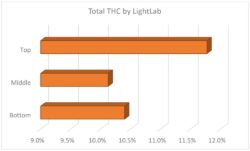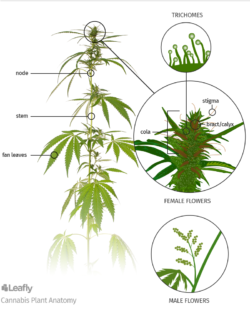Testing for Truth Part 1: Is the “best bud” at the top?
BY DYLAN WILKS, CTO
Anecdotal evidence abounds in the cannabis industry. Whether it’s a discussion about grow media, indoor vs outdoor or which strain is “best”, it can be challenging to separate fact from fantasy. Historically, anecdotal reports of cannabinoid content were all that was needed to sell product. Now that legalization is in full swing, consumers are demanding higher quality, customized, product. The shift in demand is putting pressure on producers to define their quality through hard data and hard work. Ultimately, the businesses that invest in quality control measures, and build a brand on repeatable customer experience, will be the ones who endure. In this series, we are going to set-up “Mythbusters” style experiments to explore some of the commonly held perceptions about cannabis to see whether they stand up to scientific scrutiny.
A Top to Bottom Tour of the Cannabis Plant
One of the theories we frequently hear is that the very top of a plant has flowers with much higher cannabinoid content than those on the lower branches. This makes sense if you consider that the top flowers receive more sunlight and airflow. Consumers, and more critically the medical use consumers, expect the promised effect. Over or under dosing can influence the consumers decision to make subsequent purchases from the same vendor in the future. This leads us to our Testing for Truth questions: how much of a difference is there really between top, middle and bottom flowers harvested from the same plant? And what can be done to even out cannabinoid distribution between flowers on the same plant?
We partnered with a non-commercial legal grower in Massachusetts with an outdoor grow consisting of 12 plants to find out. We chose four plants consisting of two strains that were located as far as possible from each other. A flower from the top, middle and bottom were taken from each plant, for a total of 12 samples. Each sample was separated from any large stems or fan leaves, but were not fully trimmed to avoid any variation due to trimming. Each sample was run on a LightLab Cannabis Analyzer and for this study the “Total THC” was used as a benchmark. Total THC is the sum of THCA and D9THC, not the “Total Potential THC” which is the amount of D9THC that would be present after full decarboxylation (THCA*.877+D9THC).

Testing for Truth Results: Confirmed
What we found was consistent with the anecdote in this case. The top of the plant did indeed have more potent buds. The average potency was about 15% higher than the middle or bottom. Note that while the weight percent results look low here, keep in mind these are untrimmed flowers. Interestingly, the middle and bottom flower was nearly identical, with the bottom buds actually beating out the middle ones. It turns out it is true that if you want the most cannabinoid laden flower, you should take from the top.
Discussion
Now that we know there is variation in plant potency across a single plant, what can be done with this data? If consistency is the goal, an indoor facility might consider adjusting lighting and possibly plant location to ensure that the light reaches every plant branch. For an outdoor grow, strategies such as spacing, trimming and training the plants to grow such that light reaches all branches more or less equally will be important. Understanding the variation inherent in a grow is the first step in improving quality, and ultimately increasing margins and profits.
Stay tuned for our next test: Checking the potency of a single bud top to bottom.

